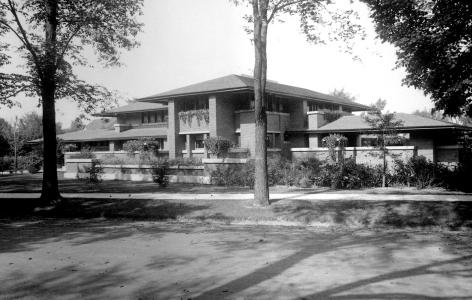Darwin D. Martin House

Date: 1903
Address: 125 Jewett Parkway, Buffalo, NY 14214
City: Buffalo, New York
Links: www.darwinmartinhouse.org
Accessibility: Public
Category: Residential
Restoration status: Pergola, stable, and garage demolished in 1960, reconstructed between 2004 and 2007
The Darwin Martin house stands as one of the largest and most significant commissions of Wright’s Chicago years. Like the Susan Lawrence Dana house, it serves as a bold expression of Wright’s powerful vision for a new American architecture. In his correspondence with Martin, Wright referred to the scheme as a “domestic symphony.” The sense of unity is revealed in every aspect of the design; the rectilinearity of the units that form the house’s T-shaped plan is reinforced by the geometry of its leaded-glass windows and custom-made furnishings. Clusters of piers in the expansive first story rooms allow for continuous bands of windows at the house’s perimeter. The piers marry distinct utilitarian and aesthetic elements by serving as structural supports, room dividers, and furniture pieces that encase radiators, light fixtures, bookcases, and shelving.
The Martin house was part of a larger complex, which ultimately included the Barton house; a long pergola connecting the Martin house to a glass-ceilinged conservatory and garage; and a gardener’s cottage. The complex was the result of a close collaboration between Wright and his colleague Walter Burley Griffin, who oversaw the project; Oscar Lang, its contractor and builder; and the Martins, who provided a steady flow of feedback concerning the design and construction of the house. The remarkable leaded glass windows of the Martin house were fabricated by the Linden Glass Co. of Chicago. The geometric, stylized plant-like forms of the windows contrast with the figurative wisteria designs found in the mosaic fireplace surround designed by Orlando Giannini, another of Wright’s frequent collaborators. Located at the heart of the house, the fireplace serves as an anchor from which everything else grows organically.